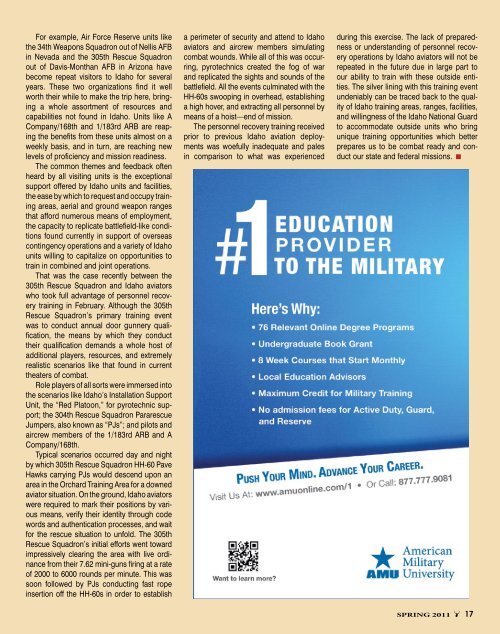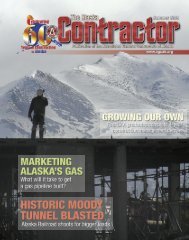The Gem State Guardian - Spring 2011 - Keep Trees
The Gem State Guardian - Spring 2011 - Keep Trees
The Gem State Guardian - Spring 2011 - Keep Trees
You also want an ePaper? Increase the reach of your titles
YUMPU automatically turns print PDFs into web optimized ePapers that Google loves.
For example, Air Force Reserve units like<br />
the 34th Weapons Squadron out of Nellis AFB<br />
in Nevada and the 305th Rescue Squadron<br />
out of Davis-Monthan AFB in Arizona have<br />
become repeat visitors to Idaho for several<br />
years. <strong>The</strong>se two organizations find it well<br />
worth their while to make the trip here, bringing<br />
a whole assortment of resources and<br />
capabilities not found in Idaho. Units like A<br />
Company/168th and 1/183rd ARB are reaping<br />
the benefits from these units almost on a<br />
weekly basis, and in turn, are reaching new<br />
levels of proficiency and mission readiness.<br />
<strong>The</strong> common themes and feedback often<br />
heard by all visiting units is the exceptional<br />
support offered by Idaho units and facilities,<br />
the ease by which to request and occupy training<br />
areas, aerial and ground weapon ranges<br />
that afford numerous means of employment,<br />
the capacity to replicate battlefield-like conditions<br />
found currently in support of overseas<br />
contingency operations and a variety of Idaho<br />
units willing to capitalize on opportunities to<br />
train in combined and joint operations.<br />
That was the case recently between the<br />
305th Rescue Squadron and Idaho aviators<br />
who took full advantage of personnel recovery<br />
training in February. Although the 305th<br />
Rescue Squadron’s primary training event<br />
was to conduct annual door gunnery qualification,<br />
the means by which they conduct<br />
their qualification demands a whole host of<br />
additional players, resources, and extremely<br />
realistic scenarios like that found in current<br />
theaters of combat.<br />
Role players of all sorts were immersed into<br />
the scenarios like Idaho’s Installation Support<br />
Unit, the “Red Platoon,” for pyrotechnic support;<br />
the 304th Rescue Squadron Pararescue<br />
Jumpers, also known as “PJs”; and pilots and<br />
aircrew members of the 1/183rd ARB and A<br />
Company/168th.<br />
Typical scenarios occurred day and night<br />
by which 305th Rescue Squadron HH-60 Pave<br />
Hawks carrying PJs would descend upon an<br />
area in the Orchard Training Area for a downed<br />
aviator situation. On the ground, Idaho aviators<br />
were required to mark their positions by various<br />
means, verify their identity through code<br />
words and authentication processes, and wait<br />
for the rescue situation to unfold. <strong>The</strong> 305th<br />
Rescue Squadron’s initial efforts went toward<br />
impressively clearing the area with live ordinance<br />
from their 7.62 mini-guns firing at a rate<br />
of 2000 to 6000 rounds per minute. This was<br />
soon followed by PJs conducting fast rope<br />
insertion off the HH-60s in order to establish<br />
a perimeter of security and attend to Idaho<br />
aviators and aircrew members simulating<br />
combat wounds. While all of this was occurring,<br />
pyrotechnics created the fog of war<br />
and replicated the sights and sounds of the<br />
battlefield. All the events culminated with the<br />
HH-60s swooping in overhead, establishing<br />
a high hover, and extracting all personnel by<br />
means of a hoist—end of mission.<br />
<strong>The</strong> personnel recovery training received<br />
prior to previous Idaho aviation deployments<br />
was woefully inadequate and pales<br />
in comparison to what was experienced<br />
during this exercise. <strong>The</strong> lack of preparedness<br />
or understanding of personnel recovery<br />
operations by Idaho aviators will not be<br />
repeated in the future due in large part to<br />
our ability to train with these outside entities.<br />
<strong>The</strong> silver lining with this training event<br />
undeniably can be traced back to the quality<br />
of Idaho training areas, ranges, facilities,<br />
and willingness of the Idaho National Guard<br />
to accommodate outside units who bring<br />
unique training opportunities which better<br />
prepares us to be combat ready and conduct<br />
our state and federal missions.<br />
SPrinG <strong>2011</strong> 17

















